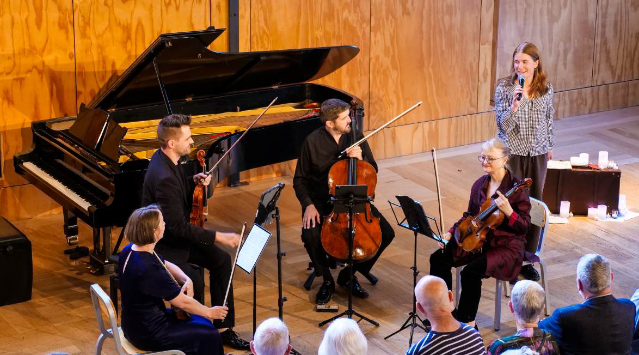 Estella Wallace introduces her new work “Of Sorrows” at the Prefab Hall, Wellington’s “Shostakovich Unpacked” – photo: Maeve O’Connell
Estella Wallace introduces her new work “Of Sorrows” at the Prefab Hall, Wellington’s “Shostakovich Unpacked” – photo: Maeve O’Connell
SHOSTAKOVICH UNPACKED – Concert Series from the New Zealand String Quartet
DMITRI SHOSTAKOVICH – Piano Quintet in G Minor Op. 57 (1940)
Sonata for Viola and Piano Op.147 (1975)
ESTELLA WALLACE – Of Sorrows, for String Quartet (2025) – world premiere
Gillian Ansell (viola, New Zealand String Quartet)
Peter Clark (violin, New Zealand String Quartet)
Anna Van Der Zee (guest violinist, New Zealand String Quartet)
Andrew Joyce (guest ‘cellist, New Zealand String Quartet)
Jian Liu, piano
Prefab Hall, Jessie St., Wellington
Tuesday, 25th November, 2025
Shostakovich and his music have never before had it quite so good in Wellington New Zealand – throughout this year of years for the composer (the fiftieth anniversary of his death) his music has undergone an exploration of a concentrated focus not previously experienced to the same extent in the capital. I recall a few great Shostakovich moments from past NZSO concerts here – among them, Kurt Sanderling (in the Town Hall in 1981) conducting the composer’s Fifth Symphony, and Vasily Petrenko (at Michael Fowler) with the epic “Leningrad” Symphony – but these were drops in the ocean compared with the relative riches served up to us during 2025. Orchestra Wellington’s stunning Shostakovich season took in the first five symphonies and a shortened concert version of the composer’s notorious opera “Lady Macbeth of the Mtsensk District” (sadly, the NZSO seemed to completely ignore the commemoration, even though given carte blanche regarding any of the ten remaining Shostakovich symphonies by Orchestra Wellington’s programming). As well, various chamber ensembles with players made up of both current and ex-New Zealand String Quartet members performed a number of the string quartets and several of the other chamber works. Yes, we could have done with some solo piano music as well (as far as I know Wellington awaits a first complete performance of the composer’s remarkable Op.87 Preludes and Fugues for solo piano) but one must instead be truly grateful for what we were enabled to receive! – in short, quite a year!
This evening’s concert in the New Zealand String Quartet’s enterprising “Shostakovich Unpacked” series gave us a delightful “bonus” item in the form of a new piece written by Estella Wallace, a student at Te Koki New Zealand School of Music, and the winner of a new “Finlayson Prize for Composition”. This competition was developed in partnership between the NZSM and SOUNZ Centre for New Zealand Music, and sponsored by the Hon. Christopher Finlayson in the form of prize money and a number of professional development opportunities for the winner – composition students had been invited to create new works “inspired by or responding to” the music of Dmitri Shostakovich.
Estella Wallace herself introduced her work “Of Sorrows” to us at the concert’s beginning, speaking about her love of Shostakovich’s music in general, and her fascination with his Viola Sonata which we were to hear tonight. She talked about using fragments and themes from the music into her work, as well as her own responses to “the tension and sorrows” of the life he had lived. Her piece tread an adroitly-shaped path balanced between tension and melancholy right from its beginning with arresting opening chords reiterated to interrupt a violin recitative, and melodic lines that followed savaged by frenetic scherzo-like figurations, the thematic material coming thick and fast, via driving trajectories and wailing melody-lines. These gave way to eerily ambient chordings from sul ponticello violins, to which the viola joined, its melody darkly “coloured” by the other instruments – introspective and truly desolate – bringing the work to a poignant conclusion. These thoughts – jotted down “on the run” – came, in the capable hands of the New Zealand String Quartet, from a powerful and deeply-engraved impression on this listener and on an appreciative audience at the end.
Perhaps it would have been even more appropriate to have played Wallace’s piece as a prelude to the Viola Sonata at the second half’s beginning – still, in view of the frequent contrasts of mood in Shostakovich’s work as a whole, it did no violence to contrast this opening piece’s sobrieties with the Piano Quintet’s arresting and flamboyantly ceremonial, neo-Baroque piano solo opening, here spectacularly and sonorously played by Jian Liu. The quartet of strings echoed the music’s declamatory splendour before setting off with the viola in attendance on a sombre waltz which, however, developed with the other instruments into a full-scale, almost epically-surging elaboration of the material of the kind the composer admired in intricate Baroque music but also felt as if it owed something to late-romantic fulsomeness!
The Fugue which followed, begun quietly by the strings and then joined by the piano, gradually became more impassioned, with the exchanges intensifying until the piano commandingly took centre-stage with a grand recitative statement followed by the other instruments in more conciliatory tones which brought our sensibilities closer to a sense of “peace”, possibly a reaction of the composer’s to the turmoil he experienced during the years leading up to the Fifth Symphony. Towards the end the strings brought out a richly-phrased theme which, together with the piano, sighed, reiterated, grumbled, and then resounded with finality.
Next, the Allegretto Scherzo danced its way cheekily into the soundscape, its somewhat artless theme nevertheless keeping the music’s energies on task with (readily inverted) clarion calls, and ”shepherding” the music back from trio-sounding excursions into vortex-like episodes which rather alarmingly build up unwanted tensions until suddenly things were defused, and brought back in line – as the famed conductor Sir Thomas Beecham once observed in a different context, this music couldn’t help but give the idea, in places, as if a lot of yaks were there all jumping about!
The Intermezzo, marked Lento brought pizzicato cello and arco violin together, joined by the viola, tones invested with exquisitely-nuanced variety by Anna Van Der Zee’s solo violin and Gillian Ansell’s viola – then with Jian Liu’s piano as a patiently sonorous guide all the strings “grew” their figured intensities in pairs, Peter Clark’s violin matching Anna Van Der Zee’s and Andrew Joyce’s ‘cello in complete accord with Gillian Ansell’s dusky utterances. And the “where to from here? question begun by a somewhat awry canonic sequence from the violins was of course resolved by the composer with the piano!
I simply adored the playing in this final movement – the piano’s initial confidence and sparkle, the strings’ moments of chromatic unease, the fanfare-like surges of hope, the continued vacillations as the strings continued to wrestle with their doubts, the viola and ‘cello seemingly more confident at times in a “come on” sort of way, and the piano always ready to rally the troops – the ending, when it came was like a musical smile of quiet relief, and certainly balm for tortured sensibilities…..a cherishable moment!
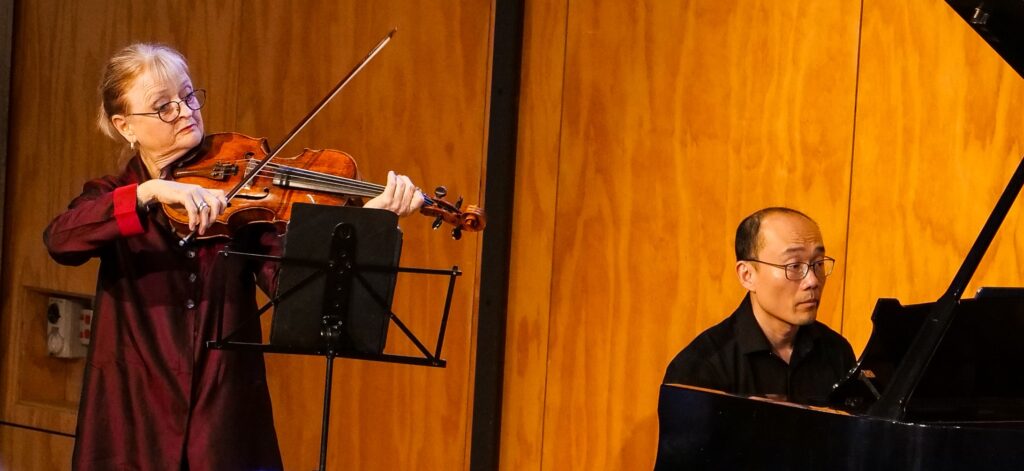 Gillian Ansell (viola) and Jian Liu (piano) play Shostakovich’s Viola Sonata – photo: Maeve O’Connell
Gillian Ansell (viola) and Jian Liu (piano) play Shostakovich’s Viola Sonata – photo: Maeve O’Connell
And then, after the interval, we found ourselves suddenly transported to the composer’s “evening”, thirty-five years later, with his valedictory Viola Sonata. At various times Shostakovich had expressed a wish to write a viola sonata to go with those for violin and cello that he had completed. He only just made it in relation to his failing health as he died in August 1975 shortly after the work was finished – he was able to tell its dedicatee, the violist Fyodor Druzhinin on July 5th 1975 that he had completed the work and sent it off to be published. The work was first performed privately at Shostakovich’s apartment on September 25th by Druizhinin, with pianist Mikhail Muntyan, and received its first public performance in October that same year from the same artists.
In her illuminating programme note Gillian Ansell told us what we needed to know regarding the music’s circumstances along with something of its character. Before beginning the performance she and Jian Liu demonstrated to us something of the significance of the composer’s frequent use in the work’s finale of recognisable phrases from Beethoven’s “Moonlight” Sonata.
Although much of the composer’s later music was dark and pessimistic, this work is different, especially in the outer movements. The first movement of this work is marked Moderato, and was described by the composer as a “novella”, a description which suggests something smaller or reduced in scale, more concentrated. The opening pizzicato notes (recalling Alban Berg’s Violin Concerto), led to a soulful kind of dialogue between the instruments, gradually leading to a great mid-movement outburst – great “schwung from both players – one followed by the piano quoting the opening pizzicato notes nd the violin playing eerie sul ponticello tones. A strange, unsettling waltz-tune followed, leading to a cadenza which interspersed the opening pizzicato notes played arco, then returning to the pizzicato at the movement’s end.
The scherzo which followed used material from the composer’s unfinished opera “The Gamblers” – we enjoyed plenty of folkish “slides” and note-bending in this sardonic and sometimes savage kind of “danse macabre” – a darkly sinister viola theme led to a kind of “trio” begun by great pizzicato and furthered by declamatory exchanges and an impassioned string solo before the dance returned, as volatile and ornery in places as before, and then gradually fading into indeterminant spaces.
The finale began with a beautifully-sustained string solo, capped off by soft pizzicato notes, out of which came the piano’s first, deeply-voiced three-note figurations bringing to mind the spirit of Beethoven, and answered by the violin’s voicing of the “Moonlight” Sonata’s theme, simply the dotted phrase’s opening with (sometimes) the first rising note of its continuation, here repeated and varied continually. It was even brought into an impassioned cadenza, whose mood then took over the viola-and-piano exchanges, as if the composer was wrestling with demons rather than fond remembrances (with quotes from his symphonies and the Second Violin Concerto tumbling through the music), before giving up the struggle and accepting that all of this was, in fact, a farewell to life. How interesting that it was the unassuming viola to which Shostakovich had given pride of place to perform this momentous task!
This concert made a brilliant and fitting finale to the New Zealand String Quartet’s richly-crafted commemorative 2025 tribute in memory of the life and work of one of the twentieth century’s most truly significant creative artists. Heartfelt bravos to all who contributed to bringing the music of Dmitri Shostakovich into such finely-crafted focus for all of us here to enjoy!
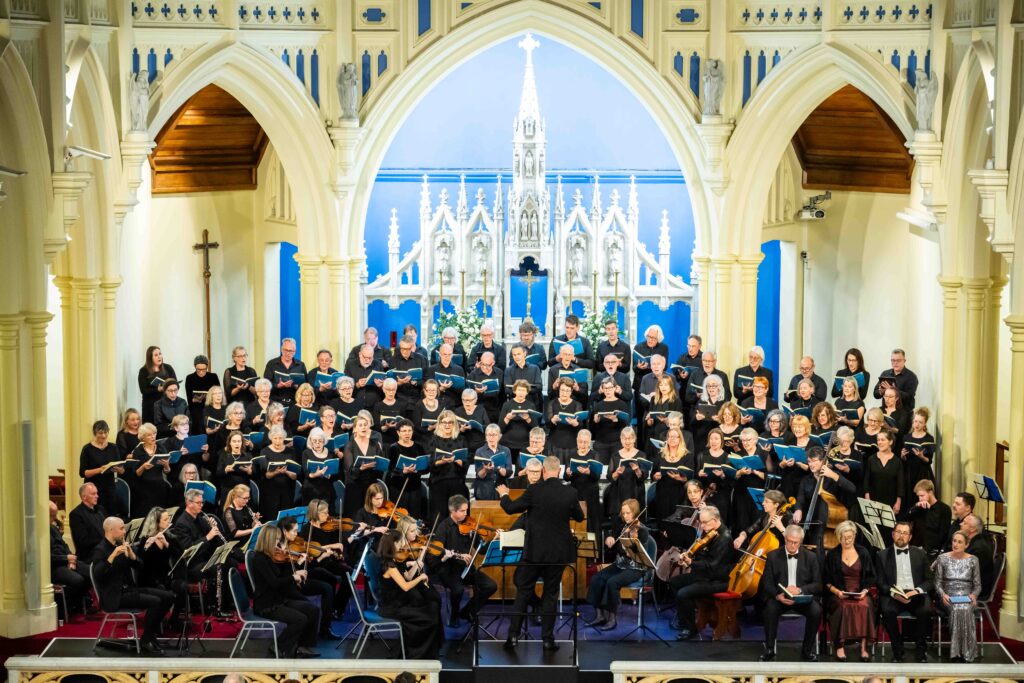 The Bach Choir, Nota Bene Choir, The Chiesa Ensemble and soloists, conducted by Shawn Michael Condon – photo, Colin McDiarmid
The Bach Choir, Nota Bene Choir, The Chiesa Ensemble and soloists, conducted by Shawn Michael Condon – photo, Colin McDiarmid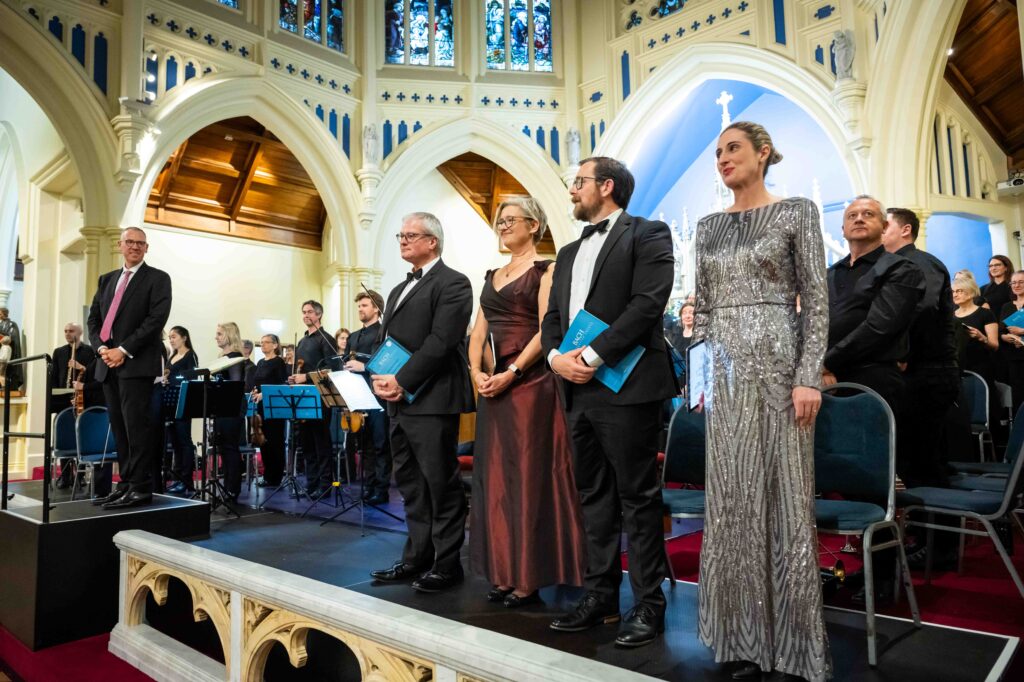 Conductor Shawn Michael Condon, with soloists Iain Tetley (tenor), Maaike Christie-Beekman (alto), Robert Tucker (bass) and Georgia Jamieson-Emms (soprano) – photo, Colin McDiarmid
Conductor Shawn Michael Condon, with soloists Iain Tetley (tenor), Maaike Christie-Beekman (alto), Robert Tucker (bass) and Georgia Jamieson-Emms (soprano) – photo, Colin McDiarmid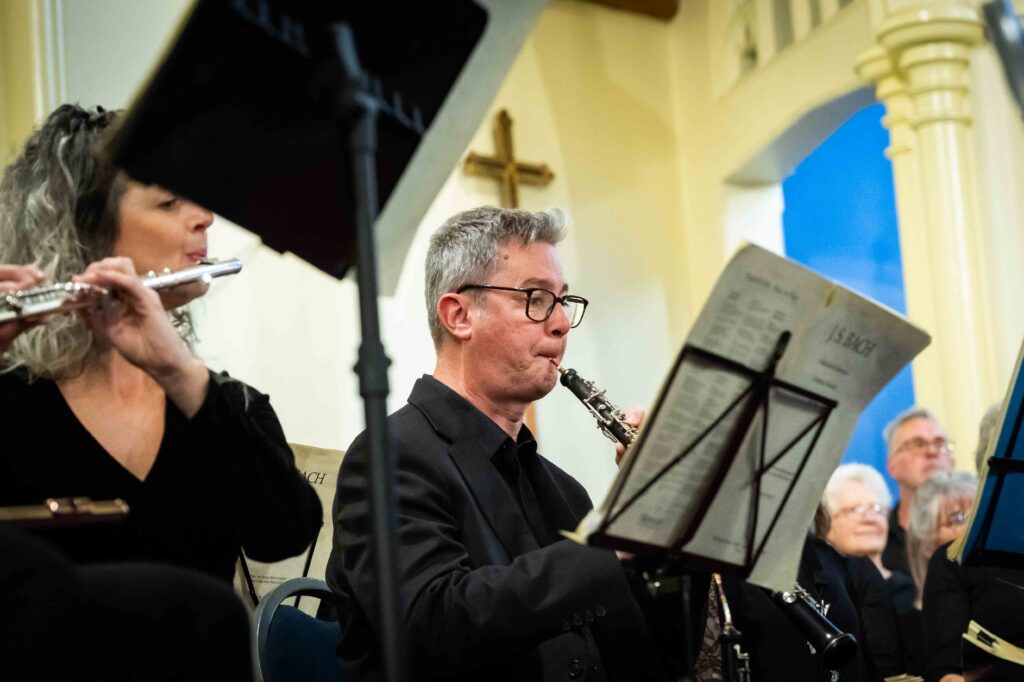 Members of the Chiesa Ensemble – Kirstin Eade (flute) and Robert Orr (oboe) – photo, Colin McDiarmid
Members of the Chiesa Ensemble – Kirstin Eade (flute) and Robert Orr (oboe) – photo, Colin McDiarmid